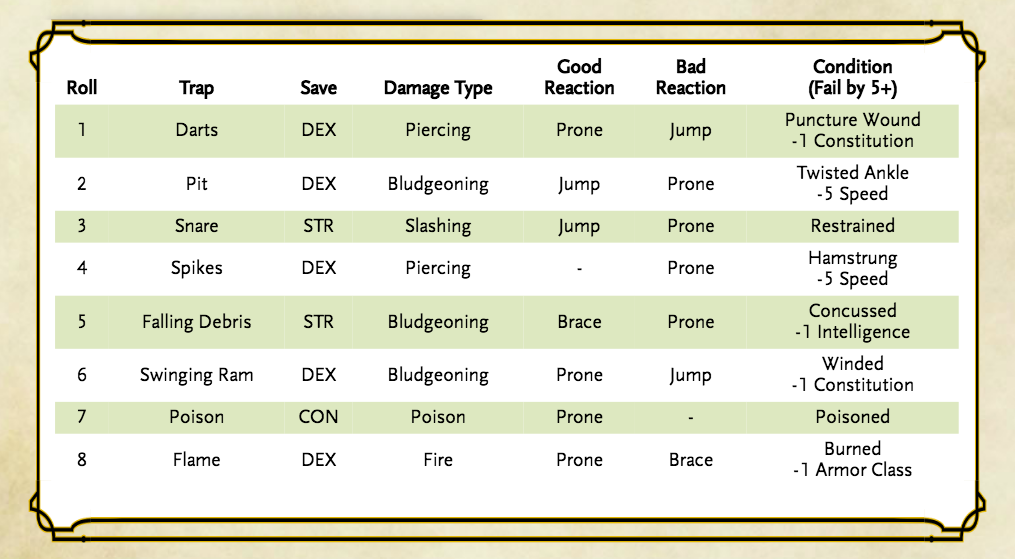Traps can be fun. A great myth is that traps need to be carefully curated to be worth anything. While curated traps are wonderful, even simple traps can be great. Here’s a simple system for running fun and impactful traps at your table:
 Download the PDF via DM’s Guild
Download the PDF via DM’s Guild
Elements of a Good Trap
For a good trap, you need flavor, interactivity, and suspense.
- Flavor comes from having a variety of traps with different effects.
- Interactivity comes from giving the players a choice that impacts the outcome of the trap.
- Suspense comes from lasting consequences that make the rolls matter.
Flavor is easy to satisfy with a list of traps that target different saves and deal various damage types. This provides a spark to describe the trap how you want.
For interactivity, some DMs employ the “click” rule–a great concept that is ripe for mechanical development. More on that later.
Suspense is achieved by imposing lasting conditions that can affect the characters in the coming battles. When doing this, you need to be careful that the effect is impactful, but not crippling.
The Click Rule
The “click” rule is often attributed to The Angry GM who popularized it in a nearly-6000-word tome. Here’s a quick summary:
The “Click” Rule
When the characters encounter a trap, the DM declares “CLICK!” Going around the table, the players have the opportunity to say how their character reacts. This decision can affect the outcome of the trap being triggered. The usual application is to confer a bonus or penalty to the saving throw.
While it’s a great concept, it’s not really a complete set of mechanics. It’s perfectly fine in the hands of an experienced DM, but without a measured hand on the difficulty dial, trap results can feel unfair or inconsequential.
Simple Trap System
While fleshing out the “click” rule, we need to be mindful of what makes a good trap. So we develop varied traps with different damage types to target different saves (flavor). We sort player reactions into groups so we can give their results mechanical teeth (interactivity). Finally, we make sure the traps are more than just an HP tax–failure should come with the risk of a lasting effect (suspense).

How It Works
In play, most reactions fall into three categories. You can brace for impact. You can jump to safety. You can go prone when your allies shout “hit the deck!” No matter how your player flavors their reaction, it will generally fall into one of these categories. As always, just rule on the edge cases.
Reactions are balanced so that riskier choices provide a greater chance of advantage with an equal risk of disadvantage. Going prone is the riskiest option. Jumping out of the way is the median option. Bracing for impact is the safest option.
Once the players have declared their reactions, announce what the trap does. Players roll a saving throw depending on the type of trap. Good reactions allow the player to roll with advantage. Bad reactions cause the player to roll with disadvantage.
If you fail your saving throw by 5 or more, you also suffer a negative condition until you take a long rest or the condition is corrected by other means, such as a lesser restoration spell, a successful Wisdom (Medicine) check, or an ally simply cuts you out of a net.
Expanding the System
Of course, this is by no means an exhaustive list of traps. However, it should provide a basis or template for adding additional traps. Just be mindful of rebalancing if you’re going to be using random rolls for traps. You especially want to keep parity between the reaction types, so that one reaction does not become an obvious choice. Other than that, damage types, saves targeted, and negative conditions can be misbalanced without too much consequence.
Reblogged this on DDOCentral.
LikeLike